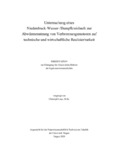Zitierlink:
http://dx.doi.org/10.25819/ubsi/9960Dateien zu dieser Ressource:
| Datei | Beschreibung | Größe | Format | |
|---|---|---|---|---|
| Dissertation_Christoph_Laux.pdf | 25.84 MB | Adobe PDF |  Öffnen/Anzeigen |
| Dokumentart: | Doctoral Thesis | Titel: | Untersuchung eines Niederdruck-Wasser-/Dampfkreislaufs zur Abwärmenutzung von Verbrennungsmotoren auf technische und wirtschaftliche Realisierbarkeit | Sonstiger Titel: | Thermodynamic and economic evaluation of a low-pressure steam Rankine cycle (LP-SRC) for the waste heat utilisation of internal combustion engines | AutorInn(en): | Laux, Christoph | Institut: | Department Maschinenbau | Schlagwörter: | Wasser-/Dampfkreislauf, Radialturbine, Abwärmenutzung, Verbrennungsmotor, Nachschaltprozess, Water/steam cycle, Radial turbine, Waste heat recovery, Combustion engine, Downstream process | DDC-Sachgruppe: | 620 Ingenieurwissenschaften und zugeordnete Tätigkeiten | GHBS-Notation: | XNR | Erscheinungsjahr: | 2020 | Publikationsjahr: | 2021 | Zusammenfassung: | Die vorliegende Arbeit befasst sich mit der thermodynamischen und wirtschaftlichen Bewertung eines Niederdruck Wasser-/Dampfkreislaufes (ND-SRC) zur Abwärmenutzung von Verbrennungsmotoren. Alleinstellungsmerkmal des ND-SRC ist, dass die Kühlmittel- und Abgaswärme in einem Einkreislaufsystem genutzt werden. Um dies zu realisieren, wird die Kühlmittelwärme zur Verdampfung des Arbeitsfluides verwendet. Das begrenzt den Verdampfungsdruck des ND-SRC auf < 1 bar absolut, da die Kühlmittelwärme mit ca. 80 °C bis maximal 120 °C auf einem relativ geringen Temperaturniveau vorliegt. Die technische und wirtschaftliche Realisierbarkeit des ND-SRC wird in dieser Arbeit für die Abwärmenutzung von motorbetriebenen Blockheizkraftwerken (BHKWen) im Leistungsbereich von 50 kWel bis 250 kWel untersucht. Für die thermodynamische Bewertung des Anlagenkonzeptes wird ein stationäres thermodynamisches Simulationsmodell mit der Software Ebsilon®Professional erstellt und anhand eines Demonstrators im Labormaßstab (BHKW mit 38 kW mechanischer Leistung) validiert. Ebenfalls werden die Methoden zur Auslegung der Wärmeübertrager und der Turbine validiert. Da das Anlagenkonzept im Leistungsbereich des Demonstrators nicht wirtschaftlich realisierbar ist, wird die Anlage auf den oberen angestrebten Leistungsbereich (BHKW mit 220 kWel) skaliert und die Kosten werden über Angebote der Zulieferungsfirmen erneut ermittelt. Die wirtschaftliche Realisierbarkeit wird exemplarisch für den Standort Deutschland mit Berücksichtigung des Kraft-Wärme-Kopplungsgesetzes 2016 ermittelt. Auf Basis der Kosten des Demonstrators und der Kostenkalkulation der skalierten Anlage wird ein Kostenmodell für den Bau eines ND-SRC erstellt, mit dem die Kosten der Einzelkomponenten über charakteristische Größen (z.B. Wärmeübertragerfläche, Turbinenleistung etc.) berechnet werden können. Anhand dieser Arbeit wird gezeigt, dass der ND-SRC in Bezug auf die elektrische Leistungssteigerung des BHKW-Motors, trotz vergleichsweise geringem elektrischen Wirkungsgrad, konkurrenzfähig zu vergleichbaren Nachschaltprozessen ist. Die berechneten spezifischen Kosten des skalierten ND-SRC zeigen, dass ein wirtschaftlich rentabler Betrieb des ND-SRC ab einer elektrischen Leistung des BHKW-Motors von ca. 220 kW möglich ist. This thesis deals with the thermodynamic and economic evaluation of a low-pressure steam Rankine cycle (LP-SRC) for the waste heat utilisation of internal combustion engines. A distinctive feature of the LP-SRC is that the coolant and exhaust gas heat are used in a single loop system. To achieve this, the coolant heat is used to evaporate the working fluid. This limits the evaporation pressure of the LP-SRC to < 1 bar absolute, as the coolant heat is present at a relatively low temperature level of approx. 80 °C to a maximum of 120 °C. The technical and economic feasibility of the LP-SRC in this thesis is investigated for the waste heat utilisation of combined heat and power plants (CHP) in the power range from 50 kWel to 250 kWel. For the thermodynamic evaluation of the plant concept, a stationary thermodynamic simulation model is developed with the software Ebsilon®Professional and validated by means of a demonstrator in laboratory scale (CHP with 38 kW mechanical power). The methods for the design of the heat exchangers and the turbine are also validated. As the plant concept is not economically feasible in the power range of the demonstra-tor, the plant will be scaled to the upper target power range (CHP with 220 kWel) and the costs will be determined again by means of offers from the supply companies. The economic feasibility is determined exemplarily for the location Germany with consideration of the combined heat and power act 2016. Based on the costs of the demonstrator and the cost calculation of the scaled plant, a cost model for the construction of a LP-SRC will be developed, with which the costs of the individual components can be calculated using characteristic values (e.g. heat exchanger surface, turbine output, etc.). In this thesis it is shown that the LP-SRC is competitive to comparable downstream processes regarding the electrical power increase of the CHP engine, despite a comparatively low electrical efficiency. The calculated specific costs of the scaled LP SRC show that an economically profitable operation of the LP-SRC is possible from an electrical power output of the CHP engine of approximately 220 kW. |
DOI: | http://dx.doi.org/10.25819/ubsi/9960 | URN: | urn:nbn:de:hbz:467-19463 | URI: | https://dspace.ub.uni-siegen.de/handle/ubsi/1946 |
| Enthalten in den Sammlungen: | Hochschulschriften |
Diese Ressource ist urheberrechtlich geschützt. |
Seitenansichten
428
checked on 28.11.2024
Download(s)
105
checked on 28.11.2024
Google ScholarTM
Prüfe
Prüfe
Alle Ressourcen in diesem Repository sind urheberrechtlich geschützt, soweit nicht anderweitig angezeigt.

